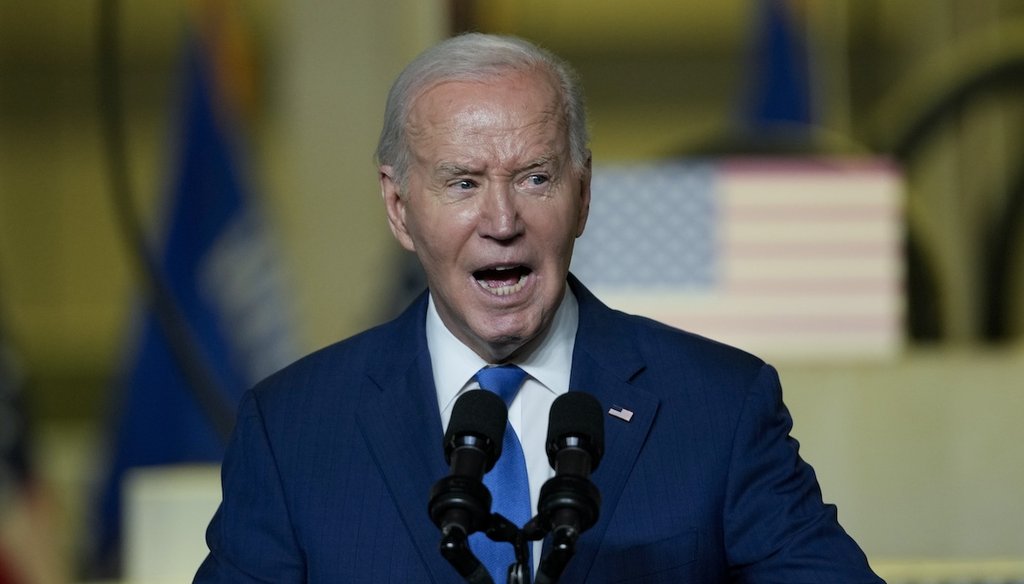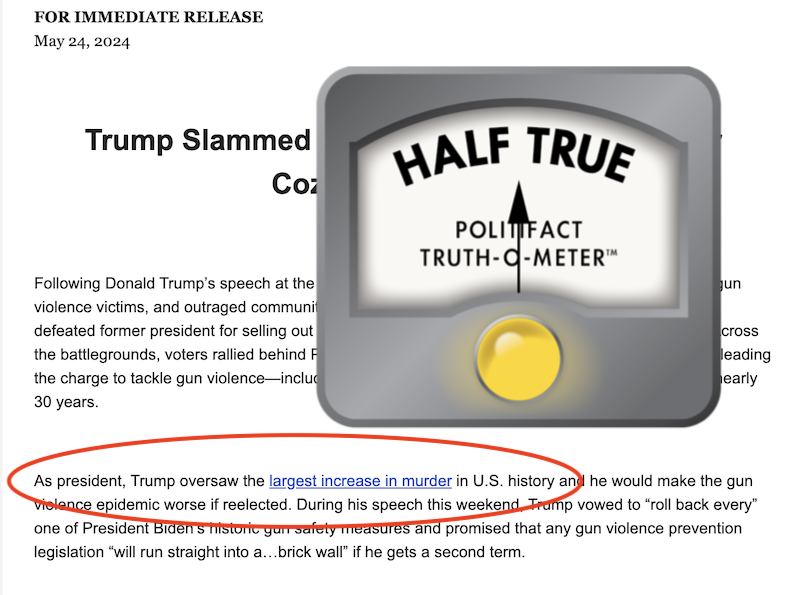Get PolitiFact in your inbox.

President Joe Biden delivers a speech during a commemorative ceremony to mark D-Day 80th anniversary on June 6, 2024 in Colleville-sur-Mer, France. (AP)
Did Donald Trump oversee the biggest-ever one-year rise in murders?
If Your Time is short
-
The number of murders in the U.S. rose by 5,795 from 2019 to 2020, when Donald Trump was president. That’s the largest one-year increase since such data began being systematically recorded in the early 1960s.
-
Crime data analysts generally attribute most of the reason for the murder spike to a complex confluence of the coronavirus pandemic and the social upheaval after George Floyd’s murder, not Trump’s actions.
President Joe Biden tore into his expected 2024 opponent, former President Donald Trump, after Trump addressed the National Rifle Association May 18.
"As president, Trump oversaw the largest increase in murder in U.S. history and he would make the gun violence epidemic worse if reelected," Biden said in a campaign email.
The email cited a September 2021 USA Today article that summarized newly released FBI crime data. The article cited a "nearly 30% increase in murders in 2020, the largest single-year jump since the bureau began recording crime statistics six decades ago."
Mathematically, Biden’s assertion holds up, but experts told us it also leaves out important context.
What the numbers show
By the FBI’s definition, "murder" refers to the willful killing of one human being by another, as determined by police investigation and not requiring judicial adjudication of a defendant or a coroner’s ruling. The definition encompasses murders and nonnegligent manslaughter. Excluded from the definition are deaths caused by negligence, suicide or accident and homicides deemed justifiable.
In 2020, the number of U.S. murders reported to the FBI increased by 5,795, from 16,619 in 2019 to 22,414.
In any previous year going back to 1961, the number had never increased by more than 2,000 in a year. So, 2020’s increase was nearly triple the previous record.
Going back to 1960, the first year of reliable national crime data, the increase from 2019 to 2020 "was the single largest one-year increase," said Ernesto Lopez, a research specialist at the Council on Criminal Justice, an independent group that studies crime statistics and policy.
It was a record-breaker both for the percentage change (about 35%) and the number of additional murder victims from one year to the next, said Jeff Asher, an analyst with the consulting company AH Datalytics who specializes in crime data.
The last year for which the FBI officially released crime data was 2022. But experts say they do not expect that 2023 or 2024 will produce an increase as large as 2020’s. Preliminary data compiled independently from a cross-section of police departments signals nationwide murder numbers will decline in both years once they are officially tallied.
A different dataset, from the Centers for Disease Control and Prevention, paralleled the FBI’s data, finding the largest homicide increase in 100 years in 2020, at 30%. (Homicide is a broader category than murder.)
One note about the FBI data: In 2021, the FBI changed how police departments report crime to the agency. Some large police departments, such as New York City and Los Angeles, did not change their reporting processes in time for the 2021 data deadline. Although that creates a larger margin of uncertainty for the FBI’s 2021 data, the agency always estimates nonreporting cities’ crime levels based on jurisdictions of similar size and demographics. Through these estimates, all cities are reflected in the data.
Also, crime statistics experts told PolitiFact that the FBI’s 2021 data tracks other crime data studies that didn’t change their methodology that year. The only year for which FBI data was affected was for 2021.
What caused the spike?
Resting blame for the 2020 murder rise solely on Trump ignores how unusual life was in the United States in 2020.
When Biden criticizes Trump’s record on job creation, he often leaves out the unprecedented swiftness and severity of the coronavirus pandemic, which hit the U.S. in March 2020. It upended the economy, changed collective travel habits, drove many people inside and temporarily left many Americans without a job and income.
When considering at crime statistics, experts said, this omission is crucial. Although the pandemic surely made 2020 unusual, so did the murder of Minneapolis resident George Floyd while in police custody. Floyd’s killing triggered a national outcry and a reckoning on racial issues.
"I would point to changing attitudes towards policing and police legitimacy as well as police pullbacks in the wake of Floyd's death as potentially primary factors behind the increase," Asher said.
Asher said that "there's evidence that increased carrying of firearms in the months after the pandemic might have acted as an accelerant further inflaming the increase."
Council on Criminal Justice CEO Adam Gelb has called the environment of 2020 "a master class in criminology," given its sudden onset, its duration and its dramatic impact on people and institutions.
Experts said it’s inaccurate to blame Trump alone for the murder spike. Most likely, all of these factors combined and fed off one another, they said. It’s "not possible to disentangle each factor from the pandemic," Asher said.
During 2021, Biden’s first year in office, the murder rate remained high. Murders rose by 122 that year compared with 2020. They did not decline immediately after Biden took office.
Murders dropped by 1,380 from 2021 to 2022, but they remained higher than before the pandemic. Only with the unofficial, projected declines in 2023 and 2024 is the annual number of murders poised to return to its prepandemic level.
Notably, today’s murder rate is far lower than it was a few decades ago — even factoring in the big 2020 spike. In 2020, there were 6.8 murders per 100,000 population. By contrast, the rate ranged from 8 per 100,000 population to 10 per 100,000 population from the early 1970s to the mid-1990s.
Our ruling
Biden said, "The last administration oversaw the largest increase in murders ever recorded."
Numerically, this is on target: The number of murders rose by 5,795 from 2019 to 2020, when Trump was president. That’s the largest one-year increase since such data began to be systematically recorded in the early 1960s.
But it’s an exaggeration to blame this rise solely on Trump. Experts say that spike was caused by a confluence of the coronavirus pandemic and the societal upheaval after George Floyd’s murder. Murders also remained higher than prepandemic levels well into Biden’s tenure.
The statement is partially accurate but leaves out important details. We rate it Half True.
Our Sources
Biden-Harris campaign, email, May 24, 2024
AH Datalytics, crime statistics dashboard, accessed June 7, 2024
Council on Criminal Justice, "Crime trends in U.S. cities: Year-End 2023 Update," January 2024
Vox.com. "One possible cause of the 2020 murder increase: More guns," June 12, 2021
New York Times, "Even as Violent Crime Drops, Lawlessness Rises as an Election Issue," May 26, 2024
USA Today, "FBI: Record surge in 2020 murders; nearly 30% increase drives spike in violent crime," Sept. 27, 2021
PolitiFact, "Joe Biden is correct that violent crime is near a 50-year low," May 28, 2024
PolitiFact, "No, crime has not 'skyrocketed' under Joe Biden, as Rep. Nancy Mace claimed," April 3, 2024
Email interview with Ernesto Lopez, research specialist at the Council on Criminal Justice, May 28, 2024
Email interview with Jeff Asher, an analyst with AH Datalytics, May 29, 2024
Browse the Truth-O-Meter
More by Louis Jacobson
Did Donald Trump oversee the biggest-ever one-year rise in murders?
Support independent fact-checking.
Become a member!
In a world of wild talk and fake news, help us stand up for the facts.









































